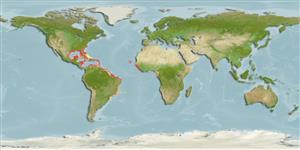Environment: milieu / climate zone / depth range / distribution range
Ökologie
seewasser riff-verbunden; tiefenbereich 8 - 100 m (Ref. 9710), usually 10 - 66 m (Ref. 13442). Subtropical; 35°N - 28°S, 98°W - 10°E (Ref. 5222)
Eastern Atlantic: Ascension Island and Gulf of Guinea islands of Principe, São Tomé, and Annobon. Western Atlantic: Bermuda, Florida, Gulf of Mexico, Campeche Bank, and throughout the Caribbean (except in northern Bahamas) to Sao Paulo, Brazil.
Size / Gewicht / Alter
Maturity: Lm ? range ? - ? cm
Max length : 30.0 cm SL Männchen/unbestimmt; (Ref. 26938); common length : 20.0 cm TL Männchen/unbestimmt; (Ref. 2739)
Rückenflossenstacheln (insgesamt): 9; Rückenflossenweichstrahlen (insgesamt): 17-19; Afterflossenstacheln 3; Afterflossenweichstrahlen: 8 - 10. Distinguished by the following characteristics: Head short (less than 35% of SL) (Ref. 26938); head and body reddish brown, paler ventrally; bright orange-red spot at the upper end of the pectoral-fin base; 3 widely spaced white spots between lateral line and dorsal-fin base; 2 blue lines on the cheek, one approximately horizontal and tangential to the lower edge of the eye, other along the upper edge of maxilla and continued onto the lower part of the cheek; depth of body contained 2.9-3.4 times in SL; subangular preopercle, vertical edge and rear half of lower edge finely serrate; subequal posterior and anterior nostrils (Ref. 89707).
Inhabits coral reefs and hard bottom areas. Observed in feeding aggregations well above the reef. Feeds mainly in midwater on zooplankton (copepods, pelagic tunicates, shrimps and shrimp larvae). Retreats instantly when alarmed (Ref. 9710).
Life cycle and mating behavior
Geschlechtsreife | Fortpflanzung | Ablaichen | Eier | Fecundity | Larven
Heemstra, P.C. and J.E. Randall, 1993. FAO Species Catalogue. Vol. 16. Groupers of the world (family Serranidae, subfamily Epinephelinae). An annotated and illustrated catalogue of the grouper, rockcod, hind, coral grouper and lyretail species known to date. Rome: FAO. FAO Fish. Synop. 125(16):382 p. (Ref. 5222)
IUCN Rote Liste Status (Ref. 130435)
Bedrohung für Menschen
Harmless
Nutzung durch Menschen
Fischereien: kleinfischerei; Aquarium: Kommerziell; Köder: usually
Mehr Information
NamenSynonymeMetabolismusRäuberÖkotoxikologieFortpflanzungGeschlechtsreifeAblaichenSpawning aggregationFecundityEierEientwicklung
ReferenzenAquakulturAquakultur ProfilZuchtlinienGenetikElectrophoresesVererbbarkeitKrankheitenVerarbeitungNutrientsMass conversion
PartnerBilderStamps, Coins Misc.LauteCiguateraGeschwindigkeitSchwimmstilKiemenoberflächeOtolithsGehirngrößeSehfähigkeit
Tools
Zusatzinformationen
Download XML
Internet Quellen
Estimates based on models
Preferred temperature (Ref.
123201): 21.2 - 28, mean 26.1 °C (based on 704 cells).
Phylogenetic diversity index (Ref.
82804): PD
50 = 0.7500 [Uniqueness, from 0.5 = low to 2.0 = high].
Bayesian length-weight: a=0.01148 (0.00558 - 0.02364), b=3.04 (2.88 - 3.20), in cm total length, based on LWR estimates for this (Sub)family-body shape (Ref.
93245).
Trophic level (Ref.
69278): 3.2 ±0.1 se; based on diet studies.
Generation time: 5.0 ( na - na) years. Estimated as median ln(3)/K based on 2
growth studies.
Widerstandsfähigkeit (Ref.
120179): mittel, Verdopplung der Population dauert 1,4 - 4,4 Jahre. (K=0.22-0.28).
Prior r = 0.44, 95% CL = 0.29 - 0.68, Based on 1 stock assessment.
Fishing Vulnerability (Ref.
59153): Moderate vulnerability (38 of 100).
Nutrients (Ref.
124155): Calcium = 29.3 [15.3, 61.4] mg/100g; Iron = 0.617 [0.322, 1.132] mg/100g; Protein = 18.6 [16.8, 20.3] %; Omega3 = 0.227 [0.132, 0.392] g/100g; Selenium = 15.6 [7.6, 31.4] μg/100g; VitaminA = 109 [35, 390] μg/100g; Zinc = 0.865 [0.557, 1.335] mg/100g (wet weight);
